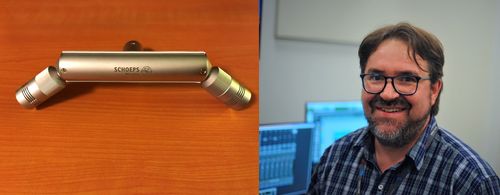'It’s an honour to own such a piece of artwork and craftsmanship. I cannot believe number 37 is still capturing fantastic sound at every concert I record, this many years after it was first assembled.'
I had been wanting the MSTC-6 for years when I found this old, beat up MSTC4. Both the capsules were deeply dented and one was hanging by its wiring! The body was also scuffed and pitted, as though it was a gigging musician’s microphone; it looked in very rough shape. But for $400, I thought I could possibly get it restored and have it in my arsenal — no more fumbling around with a pair of MK4s!
So I sent the mic back to Germany (I’m in Canada), and within a few days, received it back at my doorstep in mint condition. To say I was pleased would be an understatement; this vintage mic has a brand new look and feel to it and the sound is stunning. I put this up as my main pair and use MK21s for flanks quite often now and get comments every concert by keen mic enthusiasts who notice these things. It’s an honour to own such a piece of artwork and craftsmanship. I cannot believe number 37 is still capturing fantastic sound at every concert I record, this many years after it was first assembled. Not only are the technicians who restored it of an extremely high acumen, the initial design and craftmsanship itself allows for restorations of this calibre to be possible. I was always a fan of the sound, having been reared on these mics in school, but seeing first hand the longevity and build quality of both the new and older mics has cemented the relationship. Schoeps last forever, and are always my first call. Thanks for continuing the quality and having first-rate support for your products.
I’m truly impressed and always have been. My ears have been working in music since I was a five year old boy, and now with my Master’s degree in music, I’m able to say that I’ve encountered none finer nor more consistent. In a world where quality is the ever-increasing sacrificed element, Schoeps stands out as a rock. There are other notable mic companies who have gone in other, more corporate directions, and have thus suffered some of the subtleties the proverbial bottom-line smears out. It’s why I can keep recommending Schoeps to my students and colleagues; timeless, epic quality and durability.






